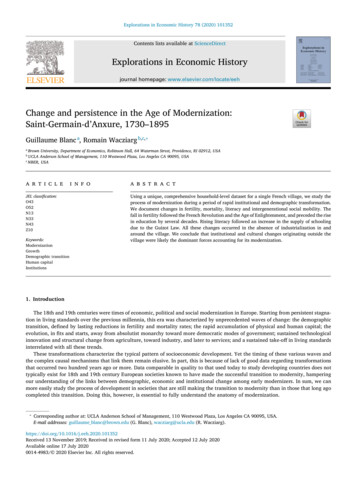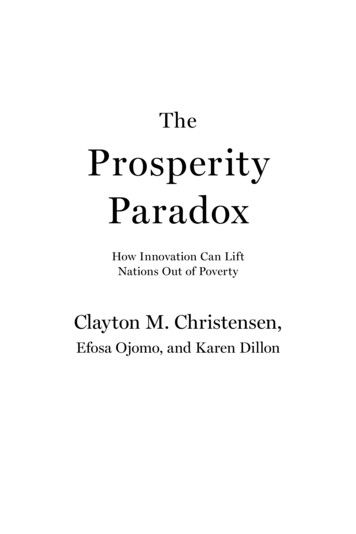
Transcription
Explorations in Economic History 78 (2020) 101352Contents lists available at ScienceDirectExplorations in Economic Historyjournal homepage: www.elsevier.com/locate/eehChange and persistence in the Age of Modernization:Saint-Germain-d’Anxure, 1730–1895Guillaume Blanc a, Romain Wacziarg b,c, abcBrown University, Department of Economics, Robinson Hall, 64 Waterman Street, Providence, RI 02912, USAUCLA Anderson School of Management, 110 Westwood Plaza, Los Angeles CA 90095, USANBER, USAa r t i c l eJEL zationGrowthDemographic transitionHuman capitalInstitutionsi n f oa b s t r a c tUsing a unique, comprehensive household-level dataset for a single French village, we study theprocess of modernization during a period of rapid institutional and demographic transformation.We document changes in fertility, mortality, literacy and intergenerational social mobility. Thefall in fertility followed the French Revolution and the Age of Enlightenment, and preceded the risein education by several decades. Rising literacy followed an increase in the supply of schoolingdue to the Guizot Law. All these changes occurred in the absence of industrialization in andaround the village. We conclude that institutional and cultural changes originating outside thevillage were likely the dominant forces accounting for its modernization.1. IntroductionThe 18th and 19th centuries were times of economic, political and social modernization in Europe. Starting from persistent stagnation in living standards over the previous millennia, this era was characterized by unprecedented waves of change: the demographictransition, defined by lasting reductions in fertility and mortality rates; the rapid accumulation of physical and human capital; theevolution, in fits and starts, away from absolutist monarchy toward more democratic modes of government; sustained technologicalinnovation and structural change from agriculture, toward industry, and later to services; and a sustained take-off in living standardsinterrelated with all these trends.These transformations characterize the typical pattern of socioeconomic development. Yet the timing of these various waves andthe complex causal mechanisms that link them remain elusive. In part, this is because of lack of good data regarding transformationsthat occurred two hundred years ago or more. Data comparable in quality to that used today to study developing countries does nottypically exist for 18th and 19th century European societies known to have made the successful transition to modernity, hamperingour understanding of the links between demographic, economic and institutional change among early modernizers. In sum, we canmore easily study the process of development in societies that are still making the transition to modernity than in those that long agocompleted this transition. Doing this, however, is essential to fully understand the anatomy of modernization. Corresponding author at: UCLA Anderson School of Management, 110 Westwood Plaza, Los Angeles CA 90095, USA.E-mail addresses: guillaume blanc@brown.edu (G. Blanc), wacziarg@ucla.edu (R. 2Received 13 November 2019; Received in revised form 11 July 2020; Accepted 12 July 2020Available online 17 July 20200014-4983/ 2020 Elsevier Inc. All rights reserved.
G. Blanc and R. WacziargExplorations in Economic History 78 (2020) 101352In this paper, we use a unique dataset for a single French village over the 1730–1895 period to make progress in this respect.This dataset, at the individual and household levels, allows us to study the process of change precisely during the time of France’stransition to economic, social and political modernity. The time period under study was crucial in French development. It includeddemographic change, political upheaval, growing literacy, and improving living standards. We study how these and other changesare linked to each other, and how village life evolved over this period of profound transformation. We pay particular attention toissues of change and persistence. We show for instance that despite growing literacy and changing demographic outcomes, there wasconsiderable intergenerational persistence in literacy status, social status and occupations. We also study the timing of change to betterunderstand the forces that underlie economic, social and institutional change in France. For instance did the rise in literacy precedeor follow the decline in fertility? Did the French Revolution constitute a structural break in terms of economic and demographicindicators? What role did economic incentives play in the decline in fertility and the rise of literacy? In sum, our goal is to provide aquantitative anatomy of modernization in a village representative of the broader forces affecting French society in a period of rapidtransformation.We study Saint-Germain-d’Anxure, a small rural village in the Mayenne département of Western France. We obtained detailed dataat the individual and household level from civil records, censuses and tax rolls for this village over a period of 165 years. We digitizednearly 7,000 handwritten birth, death and marriage records - the universe of all births, deaths and marriages recorded in the villageover this period. The data contain a wealth of information on intergenerational links, literacy status, profession, social networks, andallow a precise reconstruction of the demographics of the village over the crucial decades that straddle the French Revolution. Aunique feature of the dataset is that we can explicitly link individuals across generations. This allows for a detailed analysis of socialmobility and intergenerational persistence of various socioeconomic features, such as literacy, social classes, and occupations. Thesedata were supplemented by periodic archival information from censuses, tax rolls, and qualitative sources. While our study concernsa single village, we argue that it was typical of rural French life in the 18th and 19th century. We hope, at any rate, that we gainmore in terms of detail, granularity and specificity than what we might forego in terms of generality.Saint-Germain-d’Anxure (henceforth, SGA) is located near the geographic center of the Mayenne département, midway betweenthe region’s two major towns, Laval and Mayenne (Figure A1 - historical map of Mayenne). SGA had between 500 and 630 inhabitantsat any point in time over the period under study. Major economic activities included agriculture (wheat and barley, chestnuts, someanimal husbandry) and textile weaving. The village traces its origins back to the Saxon invasions in the 7th century. Through thecenturies that followed the crusades, a single family, the Montgiroux, exercised lordship over much of the village and surroundinglands. In 1656 the Castle of Montgiroux and surrounding lands were sold to the Cardinal de Mazarin, and in 1790 these landholdingswere divided and sold to several landowners (Figure A2 presents a map of the SGA municipality as of 1835, and Figure A3 showshistorical and contemporary photos of the main village). SGA was largely spared from the violence that surrounded the FrenchRevolution, and the royalist counterrevolution that engulfed nearby locations (the Chouannerie) did not reach the village. A full-timeschoolteacher paid by the municipality and prefecture was appointed in 1834, a school for boys was built in the village in 1841,following the Guizot Law that boosted boys’ primary schooling across France. A school for girls opened in 1859.1 In many respects,then, SGA was an ordinary village buffeted by the various historical forces that shaped the modernization of France at the end of the18th Century and throughout the 19th century.Over the period under study, SGA displays both change and persistence. Modernization took the form of profound change indemographics and human capital. Over the period 1730–1750, literacy rates for males and females averaged, respectively, 11% and5%. At the end of the sample period, over 1875–1895, literacy for both sexes averaged about 85%. Both gross and net fertility ratesdeclined by over 50%, when comparing the periods 1740–1760 and 1860–1880. Child mortality (the probability of dying before one’sfifth birthday) declined from 26% (1740–1760) to 15% (1870–1890), while life expectancy at age 20 climbed from 43 to 62 yearsbetween the first and last twenty years of our sample period. The end of feudalism and the slow transition to democracy that occurredover the span of the 19th century were associated with a broader distribution of landholdings: in our database of village households,over 1760–1780, 1% of households are recorded as owning some land, while over 1875–1895 that proportion rises to 7%. Over theperiod, we witness the transition from feudalism to local democracy, as local lords who previously had dominion over the village soldland to a broader array of landholders, and local municipal institutions supplanted church and nobility as the drivers of local publicgoods provision. Finally occupational and social class mobility increased over the 165 years that span our study: the proportion ofchildren who were in the same social class as their fathers fell from 84% in the 1780–1800 period to 67% in the 1875–1895 period.At the same time, the village was left untouched by industrialization. The share of the adult male population engaged in agricultureremained stable, at 67% in 1780–1800 and 69% in 1875–1895. SGA’s small textile weaving industry declined from 11% to 5% of theadult male population during the same period.Thus, in this village, modernization proceeded without industrialization. As we argue below, changes in demographic behaviors,human capital accumulation and social relationships coincided with a complex mix of cultural change and institutional upheavalstriggered by the Age of Enlightenment and the French Revolution. Absent from the main drivers of demographic trends, however,were any dramatic changes in the returns to human capital and to the structure of the local economy. In fact, the timing of the changesobserved at the level of the village suggests that fertility and mortality fell first. This was followed by the rise of human capital as aresult of educational mandates - in particular, the Guizot Law of 1833 subsidizing the provision of primary education. The increasein social mobility then followed. In this context, the decline of fertility is unlikely to be the result of changes in the individual orhousehold level trade-off between the quantity and quality of children. Instead, it coincided with changes in cultural attitudes, as well1The information in this paragraph is sourced from Marcadé (1899).
G. Blanc and R. WacziargExplorations in Economic History 78 (2020) 101352as the decline in child mortality. The accumulation of human capital is also unlikely to be the result of individual decisions stemmingfrom industrialization, as France overall experienced late industrialization and urbanization. The rise in literacy is more plausiblyrelated to changes in national education policies, working largely by raising the supply of educational services at the village level. Wesee little evidence of structural change away from agriculture during our sample period. In sum, the modernization of demographicbehaviors and the accumulation of human capital occur without the backdrop of industrialization, but occur contemporaneously withcultural and institutional upheavals associated with the Age of Enlightenment, the French Revolution and their aftermath.Our paper is related to a vast literature in demography, history and economics analyzing the advent of modernity in France atthe local level. We are not the first to focus on detailed data from a single village. For instance, Gautier and Henry (1958) focus ondemographic change in a single village of Normandy in the 17th and 18th centuries, Ganiage (1963) does the same for three villagesin the suburbs of Paris in the 18th century, and Weir (1995) examines the demographics of Rosny-Sous-Bois in the mid-18th century.Hadeishi (2003) studies the village of Nuits, in Burgundy, between 1744 and 1779, finding an early decline of fertility and a positivecorrelation between fertility and income. These contributions (and many others too numerous to cite here) focus almost exclusivelyon demographic change, whereas we attempt a more comprehensive account of modernization among many other dimensions: notjust demographics but also human capital, local institutions, and social mobility.2Our work also relates to a more qualitative literature in the discipline of history. Probably the most famous is LeRoy Ladurie(1975), a detailed study of a village of Southern France from 1294 to 1324 (thus very far removed from our time period). In contrastto this type of narrative study we adopt an explicitly quantitative approach. Another major contribution is Eugen Weber’s bookon the modernization of rural France between 1870 and 1914 (Weber, 1976). We deal with a somewhat earlier period. Dealingwith a more recent period of French modernization, economic historian Jean Fourastié authored a famous study of the 30 years ofeconomic growth that followed the Second World War, opening with a striking narrative describing the transformation of a singlevillage, Douelle in southwestern France, between 1946 and 1975 (Fourastié, 1979). We too document changes taking place in a singlevillage, but at an earlier time.Finally, our research contributes to a more quantitative literature on French demographic change and modernization. Referenceshere are again too numerous to survey comprehensively, so we mention but a few: Louis Henry’s comprehensive and path breakingproject using parish records to track of the evolution of French demographics prior to 1800 (Henry, 1972a; Henry, 1972b; Henry,1978; Henry and Houdaille, 1973; Houdaille, 1976, Séguy 2001); Wrigley’s (1985) study of the fall of marital fertility in 19th centuryFrance; Coale and Watkins’ (1986) study of the decline of Fertility in Europe (in particular the extensive material concerning thecase of France that this book contains); and more recently Cummins’ (2013) study of marital fertility in four villages of rural Francebetween 1750 and 1850.This paper is organized as follows: Section 2 discusses theoretical considerations and further background information on the historyand geography of SGA. Section 3 briefly describes the extensive data-gathering effort that underlies this study. Section 4 examineschange and persistence in demographic characteristics over the study period. Section 5 turns to the evolution of literacy and humancapital. Section 6 discusses structural transformation and social mobility. Finally, Section 7 concludes by discussing the sequencingof modernization in the village.2. Conceptual considerations and historical background2.1. Conceptual considerationsUnderstanding the factors that led to sustained increases in per capita income has occupied economists since the inception of thediscipline. Most accounts of the socioeconomic modernization that occurred in the 18th and 19th centuries consist of articulatingcausal relationships between four major factors, emphasizing their roles with different degrees of salience. These four factors are:technological progress and the resulting structural transformation; the accumulation of human capital; the demographic transition;and institutional change. We use these categories as a roadmap: our account of the anatomy of modernization in SGA will seek toshed light on the evolution of these four factors in the village over 1730–1895, and to articulate their likely interrelationships. Oursetting allows us to look at these changes at the household level rather than in aggregate; it allows us to precisely characterize thesequencing of the various changes; and it allows us to use intergenerational information to examine mobility in socioeconomic statusand literacy.The most ambitious and comprehensive account of the transition from stagnation to modernity is Unified Growth Theory (henceforth UGT: Galor, 2011; Galor and Weil, 2000). This theory provides an integrated articulation of the links between technologicalprogress, human capital accumulation and the demographic transition in order to account for the growth take-off. It is difficult to provide a concise summary of UGT that does justice to its intricacies, but a succinct account would be as follows: societies in Malthusianregimes escape stagnation when technological improvements become sufficiently pronounced to counteract the endogenous positiveresponse of population growth to technological progress. In the post-Malthusian regime, technological progress raises the demandfor human capital (and also incentives to supply educational services). The more pronounced incentives to accumulate human capitalmodify the trade-off between the quantity and quality of children, triggering a reduction in fertility and thus a demographic transition.2Smith (1975) studies work habits and social structure in 19th Century Cruzy, a village of Southern France, but once again does not adopt themore comprehensive approach that we pursue. In a more contemporary context, the Palanpur project comprehensively follows the modernizationof a single village in Uttar Pradesh, India, since 1957 (Lanjouw and Stern, 1998).
G. Blanc and R. WacziargExplorations in Economic History 78 (2020) 101352In the modern regime, per capita income can rise in a sustained way because technological progress is no longer counteracted by population growth. In a nutshell, the primitive force leading to modernization is technological progress, which itself can be endogenizedwith respect to some deep geographic, historical and cultural factors (Galor, 2011; Spolaore and Wacziarg, 2013).Other accounts of the growth take-off emphasize a different mix of triggers and mechanisms. For instance, in Mokyr’s historicalaccounts of the growth take-off, technological progress (knowledge) is at the center of the take-off, and the role of knowledge elites isparamount.3 A virtuous reinforcement of prosperity brought about by technological progress driven by knowledge elites came fromcultural and institutional improvements that protected the fruits of this progress from predatory rent-seeking and redistribution (forinstance a general improvement in property rights protection, and the emergence of a culture that valued progress and science).Demographic change and generalized human capital accumulation only came later, at least in the case of England, as by-products ofwhat Mokyr calls “the Industrial Enlightenment”.Yet other accounts place institutional change at the center of the process of modernization (Acemoglu et al., 2011; 2001; Greif,1993; 2006; North and Weingast, 1989), among many others), arguing that institutions are the prime cause of variation in the wealthof nations and that institutional change was a major trigger for the growth take-off associated with the Industrial Revolution.Finally, some accounts give demographic factors more prominence. The demographic transition, characterized by reductions infertility rates, is central to the process of economic and social modernization (Becker et al., 1990; Galor and Weil, 2000). Demographicchange has been particularly central to debates about French modernization in the 18th and 19th Centuries. These debates aresummarized in de la Croix and Perrin (2018), Daudin et al. (2019) and Spolaore and Wacziarg (2020). They involve two essentialdistinctions. The first distinction is between economic and cultural factors. Several authors have emphasized the importance ofchanges in economic conditions as determinants of fertility reductions (see Galor, 2005, p. 224 for a detailed typology). For instance,Diebolt et al. (2017); Diebolt and Perrin (2013) and de la Croix and Perrin, (2018) provide evidence that human capital and femaleempowerment played a role in the reduction of fertility in France in the 19th century. Others have emphasized cultural factors suchas the rise of secular norms (Blanc, 2019). Murphy (2015) argues that both education and secularization explain the cross-section ofmarital fertility rates across French dé-partements in the post-1831 era. The second distinction is between the onset and the diffusionof modern fertility behavior. Contributions in the diffusionist tradition include Coale and Watkins (1986); Spolaore and Wacziarg(2020) and Daudin et al. (2019). In these approaches, both geographic connectedness and cultural relatedness facilitate the diffusionof modern fertility norms.2.2. Saint-Germain-d’Anxure: background and representativenessWe begin our anatomy of SGA’s modernization by providing some general background information on the village, its structure,history, major features, and representativeness in the period under study.4Population.The population of the village fluctuated between 500 and 630 inhabitants between 1793 and 1891 (Table A1). Putting this in theFrench context, in 1800, more than half of the population lived in towns of less than 1140 inhabitants (BDCassini, 2017).5 This isin contrast to England, which was much more highly urbanized in the early 19th century (Bairoch and Goertz, 1986). Until 1850,population dynamics in SGA and in France overall are quite similar (Fig. 1). After 1861, SGA’s population starts to decline while thepopulation of France continues to grow. This coincides with the beginning of net out-migration from the village to larger towns, andmay account for the differential population trends between SGA and the rest of France. Comparing the population of SGA to that ofrural France (defined as people living in towns of less than 5000 inhabitants), we find almost identical evolutions, with populationgrowing by about 20% from 1800 to 1850 and declining by about 10% from then to 1890. After 1850, all population growth inFrance occurs in urban areas, while rural population declines.Geography and Infrastructure.SGA was relatively isolated, located in the center of a landlocked département, and connected to other villages merely with dirtpaths.6 Two major rivers delineated the Northeastern and Southeastern borders of the municipality: respectively the Anxure andthe Mayenne, only the second of which was navigable. The 19th century saw some improvements in infrastructure (a bridge over3Thus Mokyr (2000, p. 254) states: “The key to the Industrial Revolution was technology, and technology is knowledge”. See also Mokyr (2005,p.47), : ”The argument I propose, that technological progress is driven by a relatively small number of pivotal people, is not a call for a returnto the long-defunct “heroic inventor” interpretation of the Industrial Revolution. The great British inventors stood on the shoulders of those whoprovided them with the wherewithal of tools and workmanship. (.) Below the great engineers came a much larger contingent of skilled artisansand mechanics, upon whose dexterity and adroitness the top inventors and thus Britain’s technological success relied. These were the craftsmen,highly skilled clock- and instrument-makers, woodworkers, toymakers, glasscutters, and similar specialists, who could accurately produce the parts,using the correct dimensions and materials, who could read blueprints and compute velocities, understood tolerance, resistance, friction, and theinterdependence of mechanical parts.” Squicciarini and Voigtländer (2015, 2016) provide strong empirical evidence for a growth take-off spurredby knowledge elites.4 The discussion below draws in particular on the Communal Monography of 1899, written by the village schoolteacher E. Marcadé in preparationfor the 1900 Paris World Fair (Marcadé, 1899).5SGA also falls in the same population ballpark as the 40 villages in the Enquête Henry, where median population was 474 in 1800.6In this respect also, the village was quite typical of France. Analyzing data on road length per capita in 1793 from the Cassini database(Perret et al., 2015), we found that SGA featured 3.3 m of road per capita (in a 20 km radius from the village boundaries) while the correspondingfigure for France overall was 4.1 (including urban areas). SGA’s road density is well within one standard deviation of the French mean.
Explorations in Economic History 78 (2020) 101352140130120110100Population (index 100 in 1800)150G. Blanc and R. Fig. 1. Population growth, Saint-Germain-d’Anxure and France. Note: This figure displays population (index base 100 in 1800) for SGA, France asa whole, and rural France in the 19th century. Rural is defined as less than 5000 inhabitants. The population of SGA in 1800 was 506 inhabitants.The series starts in 1800 due to the dubious quality of the 1793 census. Source: BDCassini (2017).the Mayenne river, a road built for military purposes connecting the village to the nearby town of Mayenne, both built in the early1830s). A rail line linking Paris to Brest, stopping in Laval, started operating in 1855 (Laval nowadays is 21 km from SGA by theshortest road).Religiosity.Apart from its relative isolation, other factors set SGA apart from the rest of France. One of these specificities is the relativelyhigh level of religiosity in the Mayenne département. The literature has come to rely on the share of the clergy refusing to take the1791 oath of ecclesiastical loyalty to the Revolution (the clergé réfractaire) as a historical measure of religiosity across départementsand districts of France. This measure was compiled by Tackett (1986), and used for instance in Blanc (2019), González-Bailón andMurphy (2013), Murphy (2015), and Squicciarini (2020). The share of the clergé réfractaire in Mayenne was 72.5% (15% of Frenchdépartements had a higher share) and the same share in the district where SGA was located was 65.5% (25% of French districts hada higher share). We can see the legacy of this high level of historical religiosity in contemporary data: In Mayenne, 62% of childrenborn in 2013 were baptized as compared to an average of 32% in France overall (Besmond de Senneville, 2014). Relatedly, Churchattendance in 1966 in Mayenne was in the top quartile of French départements (Isambert and Terrenoire, 1980).Agriculture and land ownership.The economy was based mostly on agriculture (oat, wheat and barley were the major crops). In this way, the village is representative of the rest of France. Indeed, in 1788, 68% of the working population in France was in the agricultural sector, and this sharewas still 48% in both 1864 and 1894, at the end of our sample (Morrisson and Snyder, 2000, Table 12). In pre-Revolutionary Francein general, agricultural holdings took several forms: closeries were small-scale landholdings leased to farmers (closiers) through sharecropping arrangements. Métaieries were larger landholdings usually owned by nobility, also operated by farmers (métayers) under amix of monetary contracts and sharecropping arrangements. The structure of landholdings changed in the second half of the 18thcentury and then after the French Revolution, with agrarian reforms leading to enclosures and gradually limiting the use of land bythose without property rights, known in France as vaine pâture, or common pasture (Rozental, 1956). Contracts increasingly took theform of leases instead of sharecropping arrangements.After the Revolution, the feudal rights of the nobility were abolished and many métaieries were sold for the benefit of the state.7This, combined with the abolition of the right of primogeniture in 1789, led to smaller farms. These general trends for France appliedwith some qualifications to both the Mayenne region and SGA: the impact on the Mayenne region was limited as that region already7Morrisson and Snyder (2000) observe: “The abolishment of the feudal rights of nobles also enhanced the income of the lower class of farmerswho no longer were subject to work corvees and other obligations to their seigneurs. Perhaps the most important aspect was the confiscation ofchurch properties and those of many nobles. These were auctioned as biens nationaux. While the largest group of buyers were the larger farmers andbourgeois who already possessed land and had the means to acquire more, there were many from the lower ranks of the agricultural hierarchy whowere also able to acquire some of the lands auctioned by the government. As a consequence, the structure within the agricultural sector changeddramatically.”
G. Blanc and R. WacziargExplorations in Economic History 78 (2020) 101352had relatively small farms and enclosures prior to the reform period, and was therefore not primarily targeted by these reforms.8However, consistent with the national trends, we do see some fractionalization of landholdings in SGA during our sample period, asa result of the declining power of the nobility. The use of day labor (domestiques or journaliers) on farms was ubiquitous, and theseworkers represent one of the largest occupational groups in our sample.Technological progress came late to the agricultural sector in this region. Agricultural lime and manure were the main soilamendments, as phosphate-based fertilizers only came into use after 1880. Major technological innovations, including the generalizeduse of the Brabant plough and even of steam-powered combine harvester on about 10 of the largest farms, did not occur until theend of the 19th century, at the end of our sample period (Marcadé, 1899).Textile Sector.Besides agriculture, there was a small textile sector in the village throughout the 18th and early 19th centuries. Cotton progressivelyreplaced linen as the main textile product over this period. In this industry, small-scale weavers and tailors were the norm, with verylimited use of mechanization. The sector employed women disproportionately: in 1850, about 32% of married women work in thetextile sector, versu
Saint-Germain-d’Anxure (henceforth, SGA) is located near the geographic center of the Mayenne département, midway between the region’s two major towns, Laval and Mayenne (Figure A1 - historical map of Mayenne). SGA had between 500 and 630 inha










